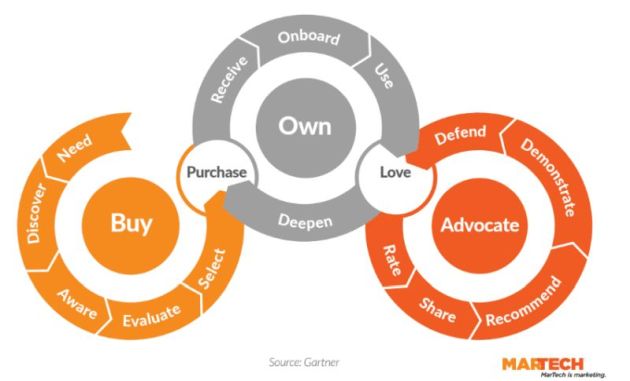Customer Experience (CX) is the customer’s takeaway of their experience with the supplier’s company, product, process and employees. Click here to see the detailed definition of CX from Gartner.
Customer’s Experience (C’sX or CSX) is the experience itself. CSX is akin to Customer Journey. As illustrated in the following exhibit, Customer Journey is what a customer encounters across the BUY, OWN and ADVOCATE phases of the Total Ownership Experience with a brand.
In short,
Customer Experience is the takeaway from Customer’s Experience.
Now that it’s clear that CX ≠ CSX, we can expect the two terms to have a different set of verbs and adjectives to express them.
Indeed they do. For example:
- You improve / enhance Customer Experience.
- You change / modify Customer’s Experience.
- You can take Customer Experience to another level. But it doesn’t make sense to do that to Customer’s Experience.
- Customer Experience can be awesome. But it’s not common to associate awesomeness with Customer’s Experience. In fact, if anyone does that, I can bet that they actually mean Customer Experience.
Let me take the opportunity to share a few thoughts on related topics like User Experience, Functionality, and Customer Service.
Good UX Can Be Bad CX
The Indian government’s Covid-19 vaccination website CoWIN is highly frictionless. Which means, it has good UX.
CoWIN uses Aadhaar Number by default for registration. Accordingly, wherever I show my vaccine certificate at, say, an airport, I use my Aadhaar Card as proof of identity. This is convenient since I anyway have my Aadhaar Card handy for other reasons (e.g. proof of ID for checking in at the airline counter, interactions with banks and telcos, etc.).
As highlighted in my blog post entitled CoWIN Certificate – Travel Ready Or Not?, the vaccination certificate posed a few challenges for overseas travelers. They were fixed subsequently with the issue of International Travel Verification Certificate.
I visited CoWIN recently to download my ITVC. As always, the UX was good.
However, ITVC replaced Aadhaar with Passport as the proof of ID. While that’s fine while traveling abroad, I now have to carry my passport whenever I need to show my vaccine certificate even within India. This is a PITA since nobody moves around with passports inside their home country. This is bad CX.
I wish CoWIN had introduced passport as an additional artefact instead of knocking out Aadhaar Card.
Bad UX Can Be Good CX

The Indian Railways’ ticket booking website IRCTC is quite clunky, especially when you use infrequent features like Cancel Partial PNR and Change Boarding Station. Ergo it has bad UX.
However it replaces the manual process of standing for hours in long lines at dingy reservation centers to book tickets at physical counters. Ergo this is good CX.
Ditto other popular websites like Craigslist, Dunzo, EaseMyTrip, IndiaMart, LinkedIn, and Naukri.
UX v. Functionality
A software (or website or app) that has more features will need more screen real estate.
There are two ways to fit them in:
- More number of screens with limited number of fields per screen
- Fewer number of screens with more number of fields per screen.
The first approach will require more number of clicks to navigate through the software. This is bad UX since one of the cardinal principles of good UX design is to minimize the number of clicks.
If the UX designer decides to take the second approach, the number of clicks will come down but the screen will become long and / or wide and will require unwieldy horizontal and vertical scrolls, which are also considered bad UX.
Getting the UX right will call for a tradeoff between the number of screens and the size of each screen, both of which depend on the software’s functionality.
Actually, in v1 of B2B S/W, this is how files were sent. Then users wanted email notif to login when file was sent. Then they wanted link to file in email. Then they wanted file as attachment in email. All of these features reduced # of clicks & were hailed as superior UX.
— Ketharaman Swaminathan (@s_ketharaman) June 23, 2021
This begs the following question:
Should UX shape functionality or restrict itself to the functionality predefined by the PM?
Most UX designers will say that UX should shape the functionality.
Which sounds fair until you take another scenario:
A website supports payments with credit card and UPI. Suddenly, it drops support for UPI. Many customers can’t make payment since they don’t have credit card. The ones that do will have to jump through more hoops to make a credit card payment because it requires two factor authentication. UX goes for a toss.
When faced with this scenario, many UX designers will wash their hands off functionality.
Which also sounds fair.
B2B UX
Forrester predicted the consumerization of Enterprise IT in 2012.
However, ten years later, it still hasn’t happened.
By popular consensus, the UX of many ERP, CRM, CBS, and other B2B products still sucks.
This is the UI of a company with a $170bn market cap pic.twitter.com/rklGPgapCI
— Alex Cohen (@anothercohen) January 18, 2022
Given that enterprise software products have a ton of features, I’d like to think their bad UX has something to do with my aforementioined point about UX v Functionality.
However, others have insinuated that bad UX is the secret of success of B2B software.
@s_ketharaman: “Enterprise software can have an opaque, hard-to-discover UI upfront… it prospers in long run by having low gross churn and high spend per customer… which make the product more indispensable” ~ @ByrneHobart.
tl;dr: SAP, SFDC, et al flourish because of – not despite – their bad UI.
CX ≠ CS
I’ve made this point a number of times in the past but it still bears repeating:
Customer Experience (CX) ≠ Customer Service (CS).
Customer Experience ≠ Customer Service. If CX does its job, you won't need CS. pic.twitter.com/tR8bXE2zbS
— Ketharaman Swaminathan (@s_ketharaman) August 28, 2019
We’ve covered the following concepts in this post:
-
- Customer Experience
- Customer’s Experience
- User Experience
- Functionality
- Customer Service
While they’re inter-related, they are not the same.
It’s important to appreciate the difference between these concepts because the tools to measure them and the tactics to improve them are different. Product managers will not get far if they use the wrong tool for the wrong purpose.
This is not product management advice but, to win, a software / website / app needs to get at least one of the above things right. As long as it does that, it might be able to coast along with subpar performance on the other areas.
By digitalizing nonexistent / painful physical processes, LinkedIn, Naukri et al provide great CX. But, by doing so with poor usability, they deliver bad UI / UX.
IME, a company can do well even if it gets just one out of UI, UX, CX right – even if it sucks at Customer Service.— Ketharaman Swaminathan (@s_ketharaman) April 4, 2022
